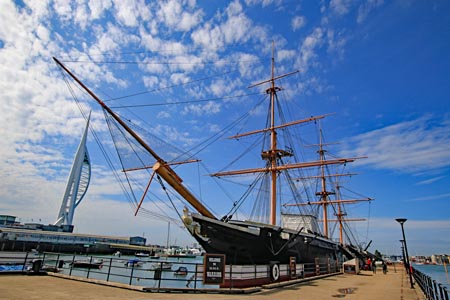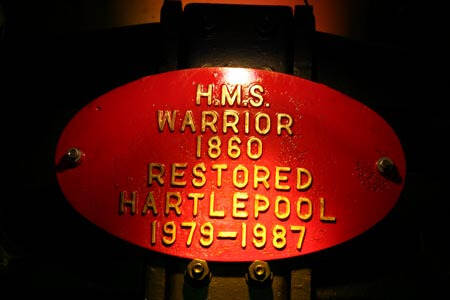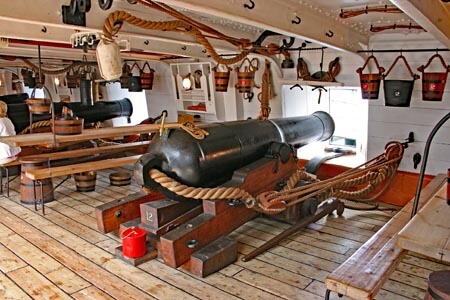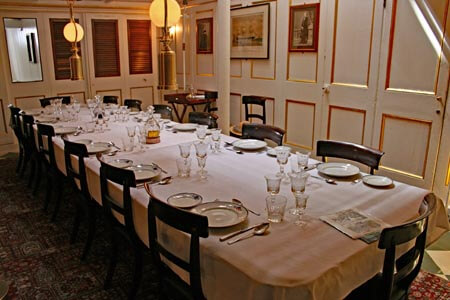HMS Warrior at Portsmouth Dockyard

HMS Warrior which is moored at the Portsmouth Historic Dockyard part of the historic ships collection, was built in response to the French armoured frigate La Glorie, the first armoured warship, and is recognized as one of the Royal Navy's most historically important warships.
In the years following the Battle of Trafalgar naval warfare and ship design in particular continued to develop.
Some naval ships similar in design to HMS Victory had been modified to include steam propulsion and the ability to be driven by propellor, but still retaining their traditional sailing rigging and masts.
The problem was that their wooden hulls provided little or no defence against the new explosive shells being developed. Some attempts to protect these warships had been made, ships such as the French navy vessel La Glorie had iron-cladding added to protect the hull from the new artillery shells.
HMS Warrior history
In response to this the Royal navy commissioned the first iron hulled armoured ship HMS Warrior in 1859. Warrior was built by Ditchburn and Mare and was launched on 29th December 1860 at Blackwall.
The new design of HMS Warrior which included an iron hull, armour plating and steam powered screw propulsion
able to produce 1250hp, was revolutionary and rendered older design warships virtually obsolete.
The central section of the hull was constructed using 4.5 inch wrought iron plate, with an 18 inch thick teak
interior backing, this provided excellent protection from enemy guns.
The steam engines were constructed by John Penn and Sons of Greenwich, required huge amounts of coal to keep
them running, sixty six stokers were needed to feed the boilers. It is believed that it took almost two days to
refuel the ship with coal. When under sail HMS Warrior was able to lower her two funnels and raise her propellor out of the water to reduce drag and enable more efficient sailing conditions.
HMS Warrior was fitted out at Victoria Docks in London, but due to the restrictions of that dock, the ship was
fully loaded up with guns, ammunition and 500 tons of coal at Greenhithe on the Thames. On 19th September 1861
she sailed to Portsmouth to undertake sea trials. Sea trials took place in the English Channel and on a cruise to
Queenstown in Ireland.

Further sea trials to Gibraltar resulted in minor damage to the ship in the Bay of Biscay and in March of 1862
she underwent a 3 month refit at Devonport.
Warrior was assigned to the Channel Squadron in 1862, this squadron was responsible for patrolling waters from
Gibraltar to Scandinavia, she was such a good deterrent that no shots were fired in anger. The ship remained a member of the Channel Squadron until 1864.
Paid off on 22nd November, a long refit followed at Portsmouth Dockyard, during which she was refitted with new muzzle loaded rifled guns of 4 inch and 8 inch, the 40 pounders on the top deck were replaced by 20 pounders.
HMS Warrior was recommissioned on 1st July 1867 and again rejoined the Channel Squadron under the command of Captain J Corbett. She took part in the review of the fleet at Spithead in July 1867. HMS Warrior carried out numerous tasks such as guard ship duty off of Osbourne House on the Isle of Wight when Queen Victoria was in residence and as an escort ship for the Royal Yacht on a visit to Dublin. In 1871 Warrior was paid off in Portsmouth and entered the naval reserve.
A further refit saw HMS Warrior fitted with new boilers and a steam powered capstan. As a ship of the reserve, her duties included a guard ship, a training ship for the Royal Naval Reserve and was also used by the coastguard service.
In 1883 HMS Warrior was paid off, the engines, boilers and guns were removed and she was laid up in Fareham creek, part of Portsmouth harbour.

HMS Warrior was taken to Pembroke Dock in Wales and was used as a landing stage at a fuel depot. When the Maritime
Trust was formed in the late 1960's, the restoration of HMS Warrior was made a priority.
The hulk of Warrior was towed to Hartlepool in 1979 and it was here that she was restored into the warship that
we can see today. The work was very labour intensive, her top deck had been covered in concrete and almost all
of the original fittings and equipment had been removed.
The restoration work took eight years at a cost of £6.5 million. Local industries in the Hartlepool area provided support and engineering apprentices from the local college provided much needed labour.
In 1987 Warrior returned to Portsmouth and is berthed at a specially built jetty at The Hard, just outside the
main entrance to Portsmouth's Historic Dockyard.
For visitor details visit the Historic Dockyard website.
HMS Warrior details:
- Commissioned: 1861
- Length: 418 feet
- Beam: 58 feet
- Displacement: 9,210 tons
- Crew: 706 men
- Address: HM Naval Base, Portsmouth, Hants, PO1 3LJ
- Telephone: 02392 728060
HMS Warrior at Portsmouth

